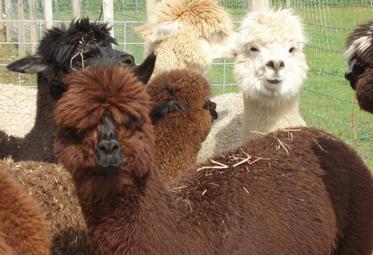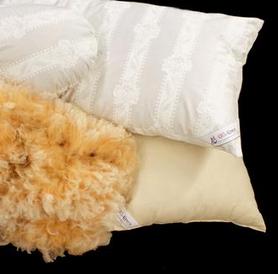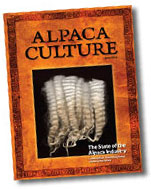About Alpaca Fiber
Come visit us and See the alpacas on our farm!
If you would like to visit the farm or ask a question about ordering your Natural Alpaca Pillow
Alpaca is softer and lighter than wool, and stronger than most normal sheep's wool. It is free from dander and lanolin, which makes it hypoallergenic, and is usually not a problem for those who can not wear wool. Alpaca are raised in a stress-free natural environment where they graze without herbicides. They are not dipped in pesticide baths, and no chemicals, dyes, or bleaches have been used during the processing. Their fiber does not contain lanolin like sheep's wool, or grease, so it is easily cleaned in a rinse bath with natural products.
Each shaft of Alpaca fiber has scales much like sheep, but they are closer to the shaft and have a more rounded edge, eliminating the itchy, "prickly" feel that wool produces. Alpaca fiber is a perfect alternative for those who suffer from allergies to sheep's wool and feathers. Alpaca fiber has a medullated core, which can be fully or partially hollow, deterring dust mites, which are the leading causes of asthma and allergies in the bedroom. This porous fiber creates an extra insulative value for a constant balance of temperature when we are in contact with it.
Alpaca is naturally fire resistant! No toxic chemicals needed!
For our allergy prone individuals this makes a great hypoallergenic fiber that organically stays clean and dry. Instead of using any chemicals to clean them, simply place in sunlight to clean and deodorize. You will be amazed how efficiently this works.
These pillows are filled with 100% U.S. Alpaca. Buying these unique
and luxurious pillows not only provides you with a comfortable,
safe, and healthy night's sleep, it supports our local U.S. farmers.
Alpaca History and Textile Properties
In regard to the domesticated llamas and alpacas, they were separated in the time of the Incas according to color: and if by chance one in a flock was born of the wrong color, it was eventually put into another flock.
___Charles Darwin
Alpacas, one of the tamed and domesticated South American camelid species are known for their quality fleece or wool. Having a resemblance with llamas, alpacas are categorized into two breeds; the Huacaya and the Suri. Huacaya breeds are identified by the presence of dense and wavy sheepish fiber while the Suri mostly possess silky fibers that offer less resistance to cold in comparison to the Huacaya fleece or wool. Huacaya breeds are found more commonly than the Suri species. However, Suri fleece is admired by the spinsters all around the world.
Alpacas have an interesting history which dates back to the ancient Andean mythological times. According to the Andean mythology, alpacas were believed to be related to “Pachmana” ( or Pachamama) which referred to the Earth mother. The natives of the Andes Mountains reckoned alpacas as a gift that had been bestowed at the Ausangate Mountains in Peru.
During the Spanish Colonial rule in Peru, alpaca fiber was deemed to be a necessity for the Inca civilization. The Incans utilized alpaca fibers in manufacturing roofs, bridges, and clothes, etc. Moreover, alpaca fiber had been used as a form of currency during the Spanish reign. In 1834, alpaca fleece was rediscovered by Titus Salt who used it to weave alpaca clothes which then became the favorite wear of the royal line. Thus, Titus brought a great industrial revolution through the usage of alpacas in interlacing clothes. In the world of today, England is counted as one of the leading producers of alpaca yarns and clothing.
Alpaca fiber, commonly known as alpaca wool is available in diversified shades ranging from Browns and whites to maroon, peaches and grays. The fiber is flexible and can be stained with any dye, thus generating an array of colors. The alpaca fibers comprise of tiny air pockets which makes them a natural thermal insulator. It possesses a high tensile strength and a lustrous appearance. Clothes being made from alpaca fiber do not have an unpleasant smell due to the absence of any grease, oil or lanolin in the fibers. It is capable of resisting solar radiation and abrasion, and is also water repellant and naturally fire resistant. Moreover, it can be merged with other synthetic fibers, thus producing new types of clothes.
Due to the durability of the Alpaca fiber, it is considered to be the best material for making fabrics, holding high demand in the textile industry. Various steps involved in the fabrication of Alpaca include the weaving, spinning, combing and finishing process similar to those involved in the manufacture of wool being derived from other animals.
Owing to the increased requirement and demand of the Huacaya and the Suri Alpaca fleece, alpacas are now bred in several countries including United States, United Kingdom, Canada, Australia and New Zealand.
Our Products are featured in these publications and we have had numerous articles written about us!
http://www.facebook.com/madeinusacertified
http://www.facebook.com/OnlyAmericanMadeHere
http://www.facebook.com/AmericanMadeMatters
Alpaca Products Care Instructions Below
Alpaca Care Instructions
KNITTED GARMENTS
We recommend either hand washing or dry cleaning by the following method:
If washing by hand:
Gently hand wash in cool water with a mild soap (we recommend special fine fibres detergent). Never use chlorine bleach. Gently press to remove excess water. Do not wring or twist. Handle gently to avoid wrinkles and distortion. Dry flat, reshaping it to its original dimensions. Smooth by hand while wet to remove wrinkles and straighten the seams and facings. Touch up with a cool iron as needed.
If dry cleaning:
Bring with you any labels or hang tags that contain fiber information or care instructions. Outfits with several pieces should be cleaned at the same time to avoid any color discrepancies resulting from cleaning. Inform the cleaner of any spots or stains, as they will want to treat some stains before the dry cleaning process.
ACCESSORIES AND WOVEN GARMENTS
Dry clean only.
OTHER TIPS
INSTRUCTIONS FOR CLEANING STAINS
INK
Absorb with baby powder, soak area in a lemon juice water solution and then in alcohol.
LIQUEUR
Wash with delicate detergent in warm water.
SAUCE
Treat first with delicate detergent in warm water and rinse with solvent.
RED WINE
Wash in cold water, then apply a lemon juice and water solution.
SWEAT
Wash in hot water, ammonia, acetic acid, then rinse in oxygenated water.
GREASE
Wash with solvent.
MAKE - UP
Wash with solvent, then wash with shampoo.
CHOCOLATE
Wash with delicate detergent and then with solvent.
PERFUME
Wash with glycerin and alcohol.
SHOE POLISH
Absorb with towel and treat stain with solvent.
TEA
Wash in warm water with delicate detergent.
COFFEE
Wash in cold to warm water with delicate detergent and treat the residual stain with solvent.
LIP STICK
Treat with alcohol.
.860-307-2143




